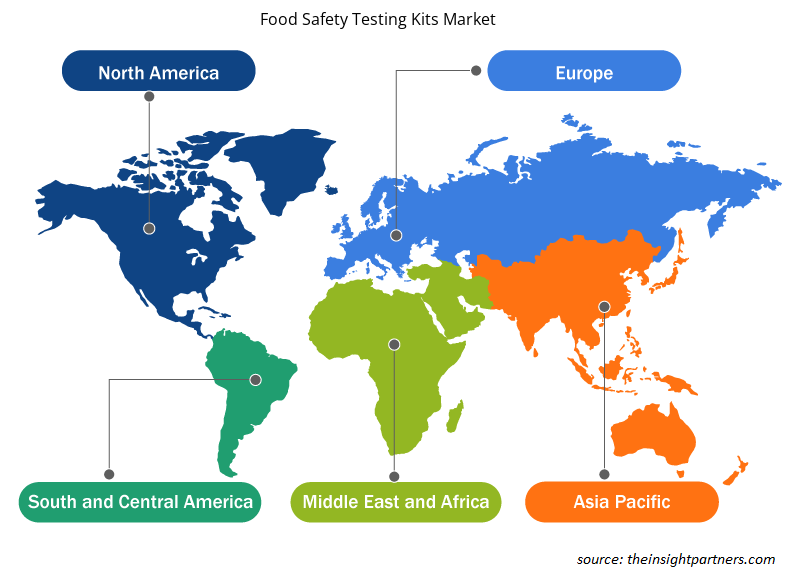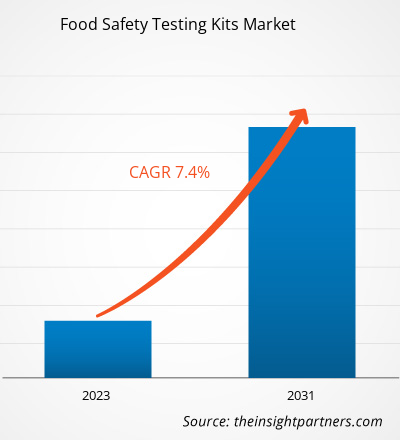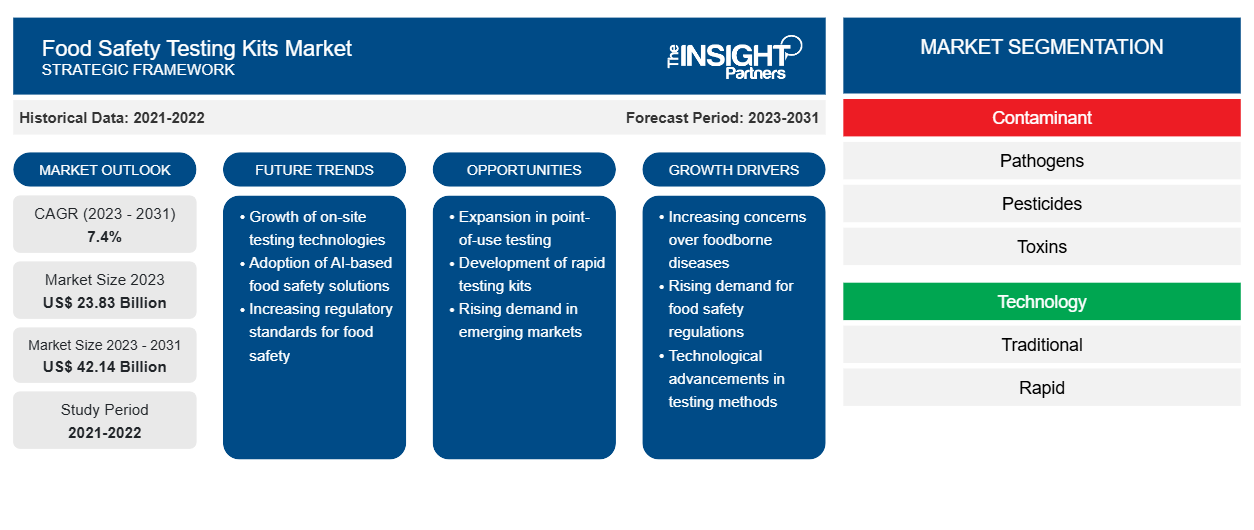Se proyecta que el tamaño del mercado de kits de prueba de seguridad alimentaria alcance los 42,14 mil millones de dólares estadounidenses para 2031, desde los 23,83 mil millones de dólares estadounidenses en 2023. Se espera que el mercado registre una CAGR del 7,4 % entre 2023 y 2031. Es probable que el crecimiento significativo de la industria de alimentos y bebidas siga siendo una tendencia clave en el mercado de kits de prueba de seguridad alimentaria.
Análisis del mercado de kits de pruebas de seguridad alimentaria
Todos los antibióticos y otros antimicrobianos se utilizan para tratar infecciones causadas por bacterias. El uso indebido y excesivo de antimicrobianos en la medicina humana y veterinaria se ha relacionado con la aparición de bacterias resistentes que hacen que el tratamiento de humanos y animales sea ineficaz. La medicina antimicrobiana se identifica como una de las mayores amenazas para la medicina moderna. Por lo tanto, se ha vuelto extremadamente importante detectar los contaminantes de antemano y evitar que ingresen a la cadena alimentaria. Por lo tanto, la importancia de los kits de prueba de seguridad alimentaria ha aumentado a nivel mundial en términos de volumen. Además, la disminución de la demanda de semillas oleaginosas y granos en los servicios de alimentos perjudicó las ventas durante 2020, se espera que la reapertura de las plataformas globales de servicios de alimentos y los precios de venta más altos impulsen el crecimiento del mercado de kits de prueba de seguridad alimentaria durante el período de pronóstico.
Descripción general del mercado de kits de pruebas de seguridad alimentaria
Las pruebas de seguridad alimentaria son un análisis científico de un producto alimenticio y su contenido para encontrar información sobre diversas características, como propiedades fisicoquímicas, composición y estructura. La información se utiliza para determinar la seguridad del producto para el consumo. La creciente prevalencia de enfermedades transmitidas por los alimentos exige pruebas de seguridad alimentaria para todos los productos alimenticios y bebidas para prevenir riesgos para la salud, lo que impulsa el crecimiento del mercado de kits de pruebas de seguridad alimentaria.
Personalice este informe según sus necesidades
Obtendrá personalización en cualquier informe, sin cargo, incluidas partes de este informe o análisis a nivel de país, paquete de datos de Excel, así como también grandes ofertas y descuentos para empresas emergentes y universidades.
-
Obtenga las principales tendencias clave del mercado de este informe.Esta muestra GRATUITA incluirá análisis de datos, desde tendencias del mercado hasta estimaciones y pronósticos.
Impulsores y oportunidades del mercado de kits de pruebas de seguridad alimentaria
El ascenso de la industria mundial de alimentos y bebidas favorecerá el mercado
La industria de alimentos y bebidas está formada por todas las empresas que participan en la distribución, el envasado y el procesamiento de materiales alimenticios. Esto incluye bebidas no alcohólicas, bebidas alcohólicas, alimentos envasados y alimentos frescos. Casi todos los productos destinados al consumo humano, excluidos los productos farmacéuticos, están incluidos en esta industria. La industria de alimentos y bebidas se está centrando cada vez más en la manipulación mecánica y la tecnología para crear productos con mayor valor añadido. Además, con el crecimiento de la población y el aumento de la clase media en los países en desarrollo, la demanda de una variedad de productos alimenticios está aumentando. Por lo tanto, la creciente industria de alimentos y bebidas impulsa el crecimiento del mercado de kits de prueba de seguridad alimentaria.
El aumento del consumo de leche: una oportunidad en el mercado de los kits de pruebas de seguridad alimentaria
El sector lácteo es uno de los más vulnerables a las enfermedades transmitidas por los alimentos, ya que los productos lácteos albergan una variedad de microorganismos. Como la pasteurización puede no destruir todos los patógenos presentes en la leche, las pruebas de la leche se vuelven esenciales para garantizar su seguridad. La leche también es uno de los productos que se consumen diariamente en grandes cantidades en todo el mundo. Por lo tanto, el alto consumo de leche conduce a un mayor volumen de kits de pruebas de seguridad alimentaria, lo que impulsa aún más el mercado.foodborne illnesses as dairy products harbor a variety of microorganisms. As pasteurization may not destroy all pathogens in milk, testing of milk becomes essential to ensure safety. Milk is also one of the products that is consumed daily in large quantities all over the world. Thus, the high milk consumption leads to a higher volume of food safety testing kits driving the market further.
Análisis de segmentación del informe de mercado de kits de pruebas de seguridad alimentaria
Los segmentos clave que contribuyeron a la derivación del análisis del mercado de kits de pruebas de seguridad alimentaria son los contaminantes, la tecnología y el tipo de alimento.
- Según los contaminantes, el mercado de kits de prueba de seguridad alimentaria se divide en patógenos, pesticidas, toxinas, OGM y otros. El segmento de patógenos se subdivide en Salmonella, E. coli, Listeria, Campylobacter, S. aureus y otros. El segmento de patógenos tuvo una mayor participación de mercado en 2023.
- En función de la tecnología, el mercado se divide en tradicional y rápido. El segmento rápido se clasifica en pruebas basadas en PCR, pruebas basadas en inmunoensayo, LAMP y otras.
- En términos de aplicación, el mercado está segmentado en productos cárnicos, avícolas y de marisco; productos lácteos; cereales y granos; alimentos procesados; frutas y verduras; y otros. El segmento de productos cárnicos, avícolas y de marisco dominó el mercado en 2023.
Análisis de la cuota de mercado de los kits de pruebas de seguridad alimentaria por geografía
El alcance geográfico del informe de mercado de kits de prueba de seguridad alimentaria se divide principalmente en cinco regiones: América del Norte, Asia Pacífico, Europa, Medio Oriente y África, y América del Sur / América del Sur y Central.
El mercado de kits de prueba de seguridad alimentaria en América del Norte está significativamente En América del Norte, el mercado de kits de prueba de seguridad alimentaria se encuentra actualmente en la fase de crecimiento y está experimentando un crecimiento exponencial. América del Norte es un centro importante para el procesamiento de alimentos. Según la Administración de Alimentos y Medicamentos de EE. UU. (FDA), 99,451 instalaciones de alimentos nacionales estaban registradas a septiembre de 2022 en EE. UU. Los países de América del Norte tienen organismos reguladores estrictos relacionados con la seguridad alimentaria. Se espera que la gran cantidad de procesamiento de alimentos en la región afecte positivamente al crecimiento del mercado de kits de prueba de seguridad alimentaria.
Perspectivas regionales del mercado de kits de pruebas de seguridad alimentaria
Los analistas de Insight Partners explicaron en detalle las tendencias y los factores regionales que influyen en el mercado de kits de pruebas de seguridad alimentaria durante el período de pronóstico. Esta sección también analiza los segmentos y la geografía del mercado de kits de pruebas de seguridad alimentaria en América del Norte, Europa, Asia Pacífico, Oriente Medio y África, y América del Sur y Central.

- Obtenga datos regionales específicos para el mercado de kits de pruebas de seguridad alimentaria
Alcance del informe de mercado de kits de pruebas de seguridad alimentaria
| Atributo del informe | Detalles |
|---|---|
| Tamaño del mercado en 2023 | US$ 23.83 mil millones |
| Tamaño del mercado en 2031 | US$ 42,14 mil millones |
| CAGR global (2023 - 2031) | 7,4% |
| Datos históricos | 2021-2022 |
| Período de pronóstico | 2023-2031 |
| Segmentos cubiertos |
Por contaminante
|
| Regiones y países cubiertos |
América del norte
|
| Líderes del mercado y perfiles de empresas clave |
|
Densidad de actores del mercado de kits de pruebas de seguridad alimentaria: comprensión de su impacto en la dinámica empresarial
El mercado de kits de pruebas de seguridad alimentaria está creciendo rápidamente, impulsado por la creciente demanda de los usuarios finales debido a factores como la evolución de las preferencias de los consumidores, los avances tecnológicos y una mayor conciencia de los beneficios del producto. A medida que aumenta la demanda, las empresas amplían sus ofertas, innovan para satisfacer las necesidades de los consumidores y aprovechan las tendencias emergentes, lo que impulsa aún más el crecimiento del mercado.
La densidad de actores del mercado se refiere a la distribución de las empresas o firmas que operan dentro de un mercado o industria en particular. Indica cuántos competidores (actores del mercado) están presentes en un espacio de mercado determinado en relación con su tamaño o valor total de mercado.
Las principales empresas que operan en el mercado de kits de pruebas de seguridad alimentaria son:
- SGS SA
- Eurofins Científico
- Grupo Intertek Plc
- TÜV SÜD
- Laboratorios AES Pvt. Ltd.
Descargo de responsabilidad : Las empresas enumeradas anteriormente no están clasificadas en ningún orden particular.

- Obtenga una descripción general de los principales actores clave del mercado de kits de prueba de seguridad alimentaria
Noticias y desarrollos recientes del mercado de kits de pruebas de seguridad alimentaria
El mercado de kits de pruebas de seguridad alimentaria se evalúa mediante la recopilación de datos cualitativos y cuantitativos posteriores a la investigación primaria y secundaria, que incluye publicaciones corporativas importantes, datos de asociaciones y bases de datos. A continuación, se incluye una lista de los avances en el mercado en materia de innovaciones, expansión comercial y estrategias:
- En mayo de 2021, Eurofins Food and Water Testing UK & Ireland anunció la adquisición de Alliance Technical Laboratories (ATL) Ltd. La adquisición mejorará la prestación de servicios de análisis de alimentos, agua y piensos de la empresa en el sudeste y forma parte de su agenda de crecimiento estratégico planificada. (Fuente: Eurofins, comunicado de prensa)
- En junio de 2021, SGS anunció la apertura de su nuevo laboratorio de análisis de alimentos en Papúa Nueva Guinea. El nuevo laboratorio ofrece pruebas de calidad reconocidas internacionalmente para los segmentos del mercado de fabricación de alimentos, hostelería y venta minorista. La instalación ofrece una amplia gama de servicios de análisis, como indicadores de microbiología de alimentos, patógenos de microbiología de alimentos, microbiología del agua y química del agua. (Fuente: SGS, Newsletter)
Informe de mercado sobre kits de pruebas de seguridad alimentaria: cobertura y resultados
El informe “Tamaño y pronóstico del mercado de kits de prueba de seguridad alimentaria (2021-2031)” proporciona un análisis detallado del mercado que cubre las siguientes áreas:
- Tamaño del mercado y pronóstico a nivel global, regional y nacional para todos los segmentos clave del mercado cubiertos bajo el alcance
- Dinámica del mercado, como impulsores, restricciones y oportunidades clave
- Principales tendencias futuras
- Análisis detallado de las cinco fuerzas de Porter y PEST y FODA
- Análisis del mercado global y regional que cubre las tendencias clave del mercado, los principales actores, las regulaciones y los desarrollos recientes del mercado.
- Análisis del panorama de la industria y de la competencia que abarca la concentración del mercado, el análisis de mapas de calor, los actores destacados y los desarrollos recientes
- Perfiles detallados de empresas
- Análisis histórico (2 años), año base, pronóstico (7 años) con CAGR
- Análisis PEST y FODA
- Tamaño del mercado, valor/volumen: global, regional y nacional
- Industria y panorama competitivo
- Conjunto de datos de Excel
Informes recientes
Informes relacionados
Testimonios
Razón para comprar
- Toma de decisiones informada
- Comprensión de la dinámica del mercado
- Análisis competitivo
- Información sobre clientes
- Pronósticos del mercado
- Mitigación de riesgos
- Planificación estratégica
- Justificación de la inversión
- Identificación de mercados emergentes
- Mejora de las estrategias de marketing
- Impulso de la eficiencia operativa
- Alineación con las tendencias regulatorias























 Obtenga una muestra gratuita para - Mercado de kits de pruebas de seguridad alimentaria
Obtenga una muestra gratuita para - Mercado de kits de pruebas de seguridad alimentaria